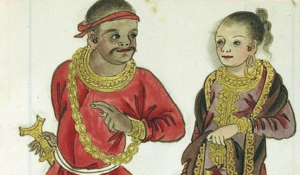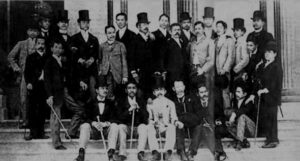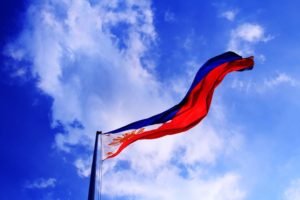Here at Talk Tagalog, probably the coolest resource for learning the Tagalog language on earth, we’ve divided our lessons into six different difficulty levels.
- Maralita (Absolute Beginner)
- Mamamayanan (Beginner)
- Maharlika (Intermediate)
- Illustrado (Upper Intermediate)
- Bayani (Advanced)
- Bathala (Godlike)
We don’t like boring stuff in Talk Tagalog so we assigned the difficult levels awesome names.
These awesome names (from Maralita to Bathala) correspond to the six CEFR difficulty levels (otherwise known as ‘common references’).
What the heck is “CEFR”?
The CEFR are standardized levels of language proficiency created by the Council of Europe a long time ago. You can read their official description of the CEFR levels.
If you want the boring version of the explanation of what these levels are and what they mean check them out in the link above. Or you can just keep reading this article.
What is the CEFR?
So again, what the heck is the CEFR?
The CEFR or Common European Framework of References for Languages is a lot of gobbledygook for a set of standardized difficulty levels used in Europe and other countries.
These difficulty levels were made so that people who deal with foreign languages (such as language learners like you and language teachers like me) can more clearly describe what kind of level of proficiency in the language is being referred to without having to get into so many details.
There are six levels: A1, A2, B1, B2, C1 and C2. Simple, aye?
This is really useful stuff.
For example, pretend you’re a Spanish learner and you apply for a job and you write on your résumé or curriculum vitae that you are “Proficient in Spanish.”
Now, this could mean a lot of things. This could mean you could deliver a lecture on astrophysics then engage in a heated philosophical debate on existentialism in Spanish. On the other hand, this could also mean that the extend of your Spanish is that you go into a bar and manage to find out from the waiter whether your favorite tapas are available or not.
So assigning foreign language skills into neat little categories with cute letter and number combinations that mean a specific things can save everyone a lot of time and perhaps embarrassment.
So yeah, we’re doing the same thing with Tagalog language. We’re putting all our lessons into these six categories. Yeah, it makes stuff much easier for you.
Talk Tagalog Difficulty Levels Explained
Okay. So you know what a hamburger is made of. Now let’s look at the patty and buns are made of.
Maralita (Absolute Beginner)
The first level on Talk Tagalog’s scale of difficulty is Maralita which would be our Absolute Beginner lessons. Maralita means someone who is indigent and mired in poverty. Well, if you are an absolute beginners in Tagalog, it’s time to have some humble pie. You’ve got to take the time to learn from the ground up, and lay those bricks to serve as a foundation to Tagalog skills.
In the CEFR scale Maralita corresponds to level A1 or ‘Breakthrough or Beginner’. This is what the official description of A1:
a) Can understand and use familiar everyday expressions and very basic phrases aimed at the satisfaction of needs of a concrete type.
b) Can introduce themselves and others and can ask and answer questions about personal details such as where he/she lives, people they know and things they have.
c) Can interact in a simple way provided the other person talks slowly and clearly and is prepared to help.
So if it’s your first day learning the language, that’s you. Or if you are still learning to express yourself, like asking directions towards the nearest toilet, that’s you.
I lumped everything that will help you get to this level, including simple set phrases, basic grammar and vocabulary, pronunciation and all that other fun stuff in this level.
Mamamayanan (Beginner)
Ako ay Mamamayan. Show me the lessons.
The second level on Talk Tagalog’s scale of difficulty is Mamamayanan which would be equivalent to simply Beginner. Mamamayanan means “citizen.” That means if you’re starting out with Talk Tagalog you become a citizen of our website – free to use, learn and grow with the Talk Tagalog’s resources.
I am really tempted to call this level something fancier, but I decided to stick with Mamamayanan again to remind everyone that the road to language proficiency is long and arduous one, fraught with danger at every turn, and we should strive to achieve higher levels of fluency. Forward march! O dear Tagalog learner!
In the CEFR scale Mamamayanan corresponds to level A2 or ‘Waystage or Elementary’. This is what the official description of A1 says:
a) Can understand sentences and frequently used expressions related to areas of most immediate relevance (e.g. very basic personal and family information, shopping, local geography, employment).
b) Can communicate in simple and routine tasks requiring a simple and direct exchange of information on familiar and routine matters.
c) Can describe in simple terms aspects of their background, immediate environment and matters in areas of immediate need.
So if you can order that adobo and ask for the price from the waiter without batting an eye, this level is for you. You’re going to find cooler stuff in this level which you can use for your next trip to Boracay.
Maharlika (Intermediate)
Fetch me the Maharlika lessons, commoner.
The third level on Talk Tagalog’s scale of difficulty is Maharlika which is equivalent to our Intermediate level.
Maharlika is the Tagalog word can roughly be translated to the aristocracy or nobility. A long time ago, the Maharlika were once the feudal warrior class in ancient Tagalog society in the Philippines. They were somewhat similar to the Spanish Hidalgos, or the freemen. The modern usage of this word however will almost always refer to roughly anyone of noble or aristocratic rank, though it is quite old fashioned.
In the CEFR scale Maharlika corresponds to level B1 or ‘Threshold or Intermediate’. This is what the official description of B1 says:
a) Can understand the main points of clear standard input on familiar matters regularly encountered in work, school, leisure, etc.
b) Can deal with most situations likely to arise while travelling in an area where the language is spoken.
c) Can produce simple connected text on topics that are familiar or of personal interest.
d) Can describe experiences and events, dreams, hopes and ambitions and briefly give reasons and explanations for opinions and plans.
If the description above fits you congratulations. Few make it this far. You deserve the title “Maharlika.” Make other Tagalog language learners green with envy as you ride a dyipni to your favorite palengke and haggle on the price of puto’t bibingka all in Tagalog.
Illustrado (Upper Intermediate)
Illustrado lessons please, kind sir.
The fourth level on Talk Tagalog’s scale of difficulty is Illustrado which would correspond to our Upper Intermediate lessons.
Illustrado (that’s pronounced i-LL-ustrado), or the “enlightened ones” were the scholarly or educated class during the Spanish colonial era. From this scholarly class hailed the great intellectuals of Philippine history, like Antonio Luna or Graciano López Jaena – guys they teach kids about in Philippine history class. The term Illustrado also carries with it the connotation of being a revolutionary, one who shapes politics and society through their ideas and intellectual works.
In the CEFR scale Illustrado corresponds to level B2 or ‘Vantage or Upper Intermediate’. This is what the official description of B2 says:
a) Can understand the main ideas of complex text on both concrete and abstract topics, including technical discussions in their field of specialization.
b) Can interact with a degree of fluency and spontaneity that makes regular interaction with native speakers quite possible without strain for either party.
c) Can produce clear, detailed text on a wide range of subjects and explain a viewpoint on a topical issue giving the advantages and disadvantages of various options.
This is the territory few Taglog learners dare venture to. But those who do make it this far win the admiration and respect of native speakers. To be an “Illustrado”, like their scholarly revolutionary namesakes, are held in awe in Tagalog language learning. This is where the real fun begins. Debate with your neig
hbor why sinigang is more authentic if cooked with actual tamarinds rather than sinigang powder mix and why halo-halo is only halo-halo if it contains milk.
Bayani (Advanced)
Give me Bayani lessons for me and my liberty
The fifth level on Talk Tagalog’s scale of difficulty is Bayani which would be our Advanced lessons.
A great poet once said that the title Bayani or “hero” cannot be stolen, bought or inherited but bestowed by the people. It is only earned through years of blood, sweat and tears, and possibly your life. Like the as Bayani of yore, such as Andres Bonifacio or the Philippine national hero Jose Rizal, the memories of the Bayani of Talk Tagalog shall live in perpetuity around the hushed campfire stories of the Talk Tagalog learning community.
In the CEFR scale Bayani corresponds to level C1 or ‘Effective Operational Proficiency or Advanced’. This is what the official description of C1 says:
a) Can understand a wide range of demanding, longer clauses, and recognize implicit meaning.
b) Can express ideas fluently and spontaneously without much obvious searching for expressions.
c) Can use language flexibly and effectively for social, academic and professional purposes.
d) Can produce clear, well-structured, detailed text on complex subjects, showing controlled use of organizational patterns, connectors and cohesive devices.
Those have been bestowed with Bayani Tagalog proficiency level are on a league of their own. Give a speech to a packed stadium of swooning fans at the Araneta Coliseum, or rouse the emotions of the masses at rally in EDSA with a fiery tirade. Or perhaps, you merely can bask in the knowledge that your bust will cast its thousand-year stare down mere ordinary folk awestruck in austere halls of Philippine history.
Bathala (Godlike)
The sixth and final level on Talk Tagalog’s scale of difficulty is Bathala. This level contains lessons that belong to the Godlike level of language difficulty lessons.
According to the indigenous religious beliefs of the Tagalog people, Bathala is the all-mighty deity who created the universe.
In the CEFR scale Bathala corresponds to level C2 or ‘Mastery or proficiency’. This is what the official description of C2 says:
a) Can understand with ease virtually everything heard or read.
b) Can summarize information from different spoken and written sources, reconstructing arguments and accounts in a coherent presentation.
c) Can express themselves spontaneously, very fluently and precisely, differentiating finer shades of meaning even in the most complex situations.
The existence of Tagalog learners who have been bestowed with Bathala-level status is legendary. It is the attainment of immortality in Tagalog learning.
Ascend to the skies with your scintillating wings of Tagalog proficiency. Change the world and achieve world peace with the great power within.

Photocredit: Philippine Department of Tourism
Where to begin?
The journey of a thousand miles starts with a single step… or a single stroke of the paddle.






